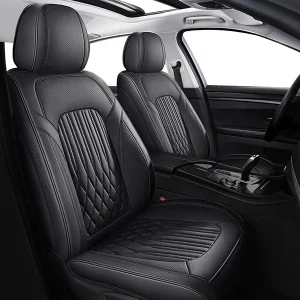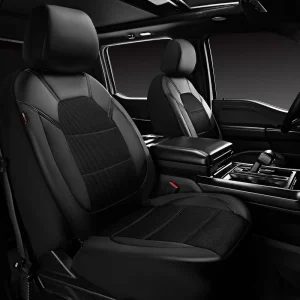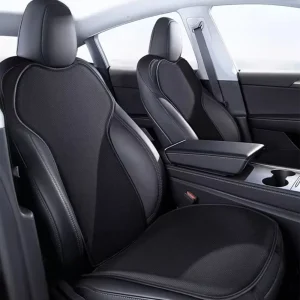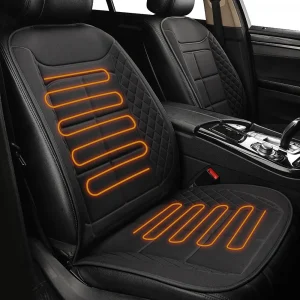Poche cose sono più tristi che salire in un'auto che ha scottato sotto il sole: sedili roventi, aria soffocante e un'ondata istantanea di disagio. Quel tipo di calore può rendere insopportabile anche un breve viaggio in auto. Nei climi caldi, l'estate non mette solo alla prova la pazienza, ma mette anche alla prova i limiti del comfort della tua auto, soprattutto quando si tratta di scegliere... materiali per fodere per sedili auto.

Il problema: sedili surriscaldati e spostamenti sudati
Il caldo può trasformare l'abitacolo del tuo veicolo in un forno. Tradizionale materiali dei sedili Materiali come la pelle o il vinile sintetico spesso trattengono calore e umidità, rendendo i sedili appiccicosi, scomodi e talvolta poco sicuri. Questo influisce sul comfort di guida e può ridurre la concentrazione e aumentare l'affaticamento, soprattutto durante i lunghi viaggi.
La soluzione: scegliere il materiale giusto per il rivestimento del sedile
Non tutti i coprisedili sono uguali. Scegliere un materiale progettato per gestire il calore, assorbire l'umidità e rimanere traspirante è fondamentale per godersi un viaggio confortevole. La scelta giusta può fare una differenza notevole in termini di temperatura, pulizia e durata.
Chi ha bisogno di questa guida?
- Conducenti in climi caldi e secchi
- Pendolari a lunga distanza
- Chiunque apprezzi il comfort e la qualità degli interni
1. Cosa rende una fodera per sedile auto adatta alla stagione calda?
Caratteristiche indispensabili
- Traspirabilità: Permette la circolazione dell'aria e riduce l'accumulo di sudore
- Traspirante: allontana il sudore dalla pelle e si asciuga rapidamente
- Resistenza ai raggi UV e al calore: Riduce al minimo la temperatura superficiale e previene la formazione di crepe o lo sbiadimento del materiale
Cose belle da avere
- Durata: Resiste all'usura quotidiana
- Facile pulizia: Respinge macchie, batteri e odori
- Ecologico: Sono disponibili opzioni non tossiche e sostenibili
2. I 5 migliori materiali per le fodere dei sedili auto per l'estate
Maglia 3D Tessuto (Struttura a nido d'ape)
- Perché funziona: Progettato con una maglia tridimensionale che aumenta il flusso d'aria
- Benefici: Ottima dissipazione del calore, leggero, mantiene la forma
- Ideale per: Conducenti con molti chilometri, proprietari di SUV e veicoli aziendali
Miscele di fibre di bambù

- Vantaggio naturale: Antibatterico, assorbente, naturalmente fresco al tatto
- Ecologico: Prodotto da fonti rinnovabili, senza sostanze chimiche
- Attento: Scegli trame dense per evitare la formazione di pallini o sfilacciamenti
Fibre sintetiche rinfrescanti
- Guidato dalla tecnologia: Progettato per regolare attivamente la temperatura corporea
- Prestazione: Assorbe il calore e migliora il flusso d'aria
- Ideale per: Zone desertiche e conducenti sensibili al caldo
Biancheria
- Fascino classico: Leggero, traspirante e naturale
- Aumento dello stile: Aggiunge un'estetica organica ed elegante al tuo interno
- Limitazioni: Tende a raggrinzirsi; potrebbe richiedere una manutenzione più frequente
Microfibra traspirante
- Comfort quotidiano: Imita la pelle scamosciata, sensazione morbida, ottimo controllo dell'umidità
- Durata: Di lunga durata e resistente alle macchie
- Suggerimento professionale: Cerca supporti antiscivolo per mantenere le coperture in posizione
3. Cosa evitare quando fa caldo
Alcuni materiali fanno più male che bene quando la temperatura aumenta:
- Pelle (vera o sintetica): Assorbe rapidamente il calore, non è traspirante, può bruciare al contatto
- Velluto/Velluto: Intrappola calore e umidità, difficile da pulire, non igienico
- Poliestere economico: Soffoca, emana spesso cattivo odore quando viene riscaldato, soggetto a rapida usura
4. Usare la pelle? Ecco come sopravvivere al caldo
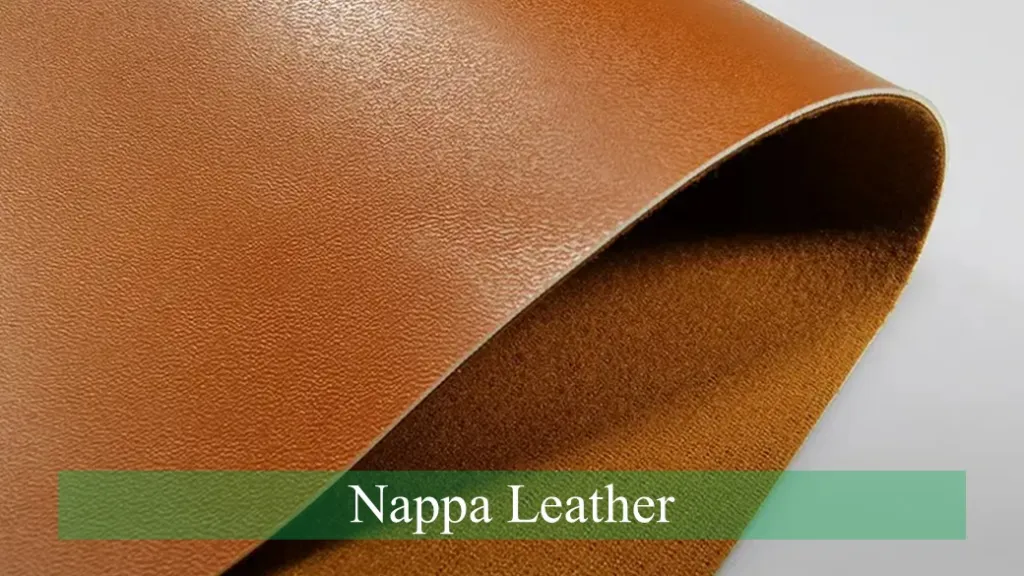
Gli svantaggi
- Diventa estremamente caldo alla luce diretta del sole (la temperatura superficiale può superare i 60°C / 140°F)
- Crepe e sbiadimenti con esposizione prolungata ai raggi UV se non adeguatamente manutenuti
- Una scarsa traspirabilità provoca sudorazione eccessiva e disagio durante i lunghi viaggi
Come gestirlo
- Scegli la pelle traforata: Le microperforazioni consentono un migliore flusso d'aria, riducendo la ritenzione del calore
- Strato con inserti traspiranti o cuscini in rete: Agiscono come un tampone e aiutano a dissipare il calore
- Applicare prodotti per la cura della pelle con protezione UV: Utilizzare prodotti progettati per gli interni delle auto con SPF o agenti bloccanti UV
- Utilizzare i parasole e i coprisedili quando si parcheggia: I parasole riflettenti riducono significativamente la temperatura dell'abitacolo
- Ventilare prima di guidare: Aprire porte/finestre per qualche minuto prima di entrare in macchina
- Evitare detergenti a base di alcol in estate: Possono seccare la pelle e accelerarne la screpolatura
Consigli per la cura della pelle in estate
- Pulito sudore e sporcizia regolarmente con un panno umido e un detergente per pelle a pH bilanciato
- Applicare il balsamo ogni 1-2 mesi durante l'estate per mantenere la morbidezza
- Evitare l'esposizione diretta alla luce solare per periodi prolungati, ove possibile
Alternative migliori
- Pelle PU microforata
- Ibridi in pelle e rete per la ventilazione
5. Suggerimenti per l'acquisto e la manutenzione
Scegli colori chiari
- Il beige, il grigio chiaro e il marrone chiaro riflettono il calore meglio del nero o del blu navy.
Ottieni la giusta vestibilità
- Scegli coperture semi-personalizzate o specifiche per il veicolo che non interferiscano con gli airbag.
Fallo durare
- Scegli materiali lavabili e resistenti alla muffa
- Abbinalo a cuscini ventilati o ventilatori ad energia solare per un ulteriore raffreddamento
Considerazioni finali
Scegliere il giusto coprisedile per auto può trasformare la tua esperienza di guida durante i mesi estivi. Che tu sia bloccato nel traffico o che tu stia viaggiando su un'autostrada soleggiata, il materiale giusto mantiene la schiena fresca, l'auto fresca e il tuo umore intatto.
Da traspirante Tessuto a rete 3D e naturalmente fresco miscele di fibre di bambù, all'alta tecnologia sintetici rinfrescanti, classico biancheriae ultra-confortevole microfibra, non mancano certo le scelte intelligenti pensate per i climi caldi. Ognuna offre un diverso equilibrio tra flusso d'aria, controllo dell'umidità e durata, così puoi scegliere quella più adatta al tuo stile e alle tue esigenze di guida.
Se stai semplicemente cercando il miglior materiale per coprisedili In generale, non solo quando fa caldo, spesso si tratta di trovare il giusto equilibrio tra comfort, manutenzione, estetica e prestazioni. La pelle può offrire un'eleganza ineguagliabile, ma la rete traspirante o la microfibra potrebbero offrire maggiore comfort quotidiano e versatilità. In definitiva, la scelta migliore è quella che si adatta sia al clima che allo stile di vita.
Investi in materiali che si adattano alle condizioni atmosferiche, non contro di esse, e fai in modo che ogni viaggio estivo sia un'esperienza da attendere con ansia.
Pronti a rinnovare la vostra auto per il caldo? Scoprite le nostre fodere per sedili estive di alta qualità su Covers4Car e trova la soluzione perfetta per il tuo stile di vita.

